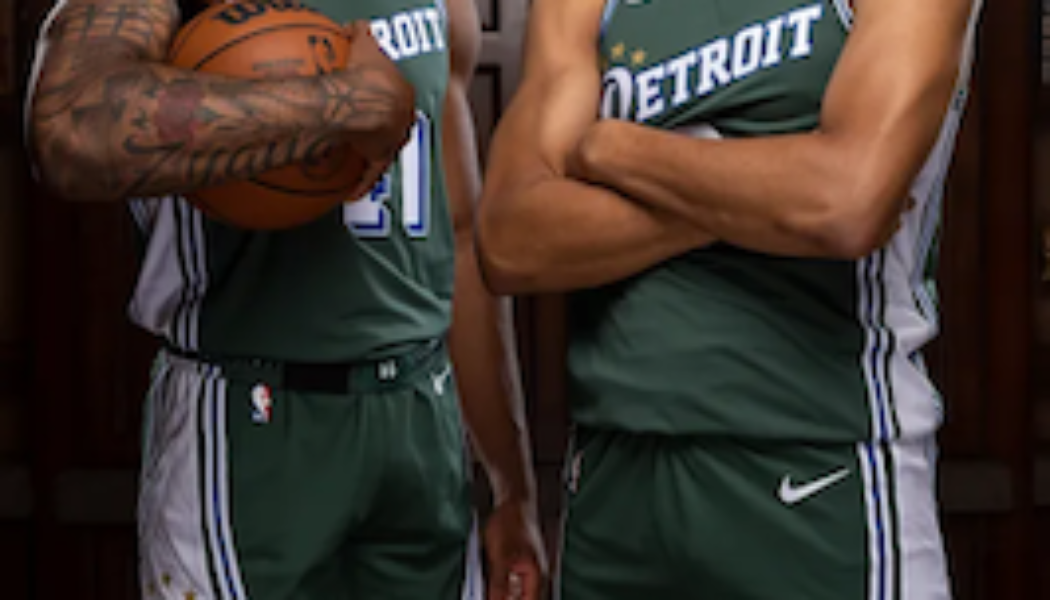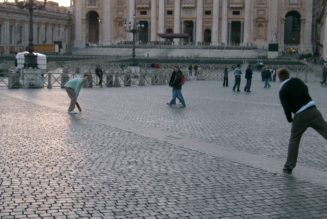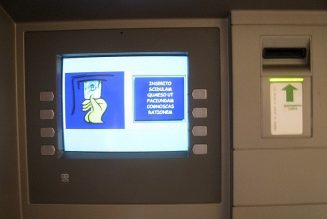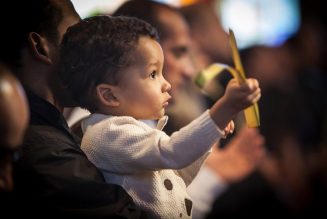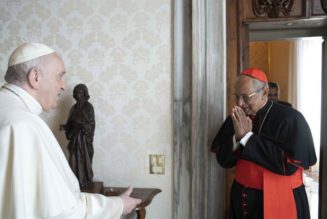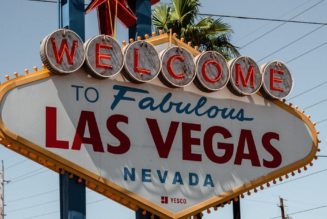Hey sports fans,
Today is the feast of St. Cecilia, and you’re reading The Tuesday Pillar Post.
There’s a lot to say about St. Cecilia, but I’d like to tell you about her basketball gym, on Detroit’s west side.
In the summer of 1967, a riot spread across urban Detroit, leaving 43 people dead, more than 7,000 arrested, and hundreds of buildings – entire neighborhoods, nearly – destroyed by fire.
The riots exploded after decades of housing, policing, employment, and educational discrimination in Detroit.
They were set off on a hot summer night in late July, after police raided an unlicensed bar and arrested more than 80 people celebrating the return of soldiers from Vietnam. An onlooker threw a bottle at a police officer, looting began, and soon there were clashes between police and rioters, merchants and looters, with fires breaking out and firefighters facing violence.
The next five days of rioting shaped the future of some Detroit neighborhoods for decades.
But after the riots, in west Detroit that summer, a gym teacher named Sam Washington and a priest named Fr. Raymond Ellis decided to open the gym of St. Cecilia’s High School for local kids, who were looking for a place to go as their neighborhood recovered from the violence.
Coach Washington put on clinics that summer and hosted pickup games, which soon became a summer league. He did the same thing each summer after that. A few years later, a Detroit Piston named Dave Bing stopped by, and then started bringing friends for pickup games.
The youth summer league spawned a very tough summer tournament, for some very talented up-and-comers — many of whom became NBA stars.
It was “the Drew League before the Drew League,” Detroit hoopers say.
Under the leadership of Coach Washington, St. Cecilia’s gym became a place where thousands of young men learned a hard-nosed, hard-work style of basketball. It hosted tournaments drawing teams from around the world. Neighborhood spectators packed the stands to watch games, as the gym became a locus of community, where NBA players and neighborhood kids have hooped together on a creaky wooden floor.
St. Cecilia’s – the kids called it “The Saint” – had no air conditioning and not much money, but it had a commitment to the people of its neighborhood.
The high school has closed, and the parish has merged with another — and some things at the gym have changed. But its commitment to the neighborhood hasn’t. That commitment has shaped culture and community in Detroit for decades.
This season, the Detroit Pistons are wearing an alternate uniform in a few games, which pays tribute to “The Saint” — it’s got stained-glass windows on the shorts, and matches the color scheme of the little parish gym that’s launched a lot of lives.

St. Cecilia, I’m sure, is interceding for her Detroit parish church, and its gym, and the thousands of kids who’ve learned basketball fundamentals there.
May she intercede for us as well.
Now here’s the news.
—
Copa Mundial
If you’re a sports fan, you know the World Cup began in Qatar on Sunday — but not without real controversy, over both working conditions and human rights in the country, and over the way Qatar bid to host the Cup in the first place.
As early as 2015, some churchmen, including Cardinal Ranier Maria Woelki, urged a boycott of the Qatar World Cup over those issues.
So before the games kicked off Sunday, The Pillar talked with Bishop Paul Hinder, apostolic vicar of Northern Arabia, who is shepherd and pastor to the 200,000 – 300,000 Catholics in Qatar.
Given the perilous state of religious liberty in the country, it’s perhaps unsurprising that Hinder spoke diplomatically, but he also gave a view of the Cup, and its controversy, from the parish level — complete with the insight that most Christians in Qatar follow cricket, not soccer.
—
In Qatar, Portugal’s national soccer team is not a favorite to win the Cup, but it is a top-ten national team in the world, and with a few lucky bounces, could go deep in the tournament.
Coach Santos is a thoughtful and practicing Catholic, with insight on faith, the interior life, and the call of Christians to be witnesses of faith.
He also talked about the outsize role of superstitions in soccer culture. Read all this:
I spent a lot of years on the other side. I didn’t have real faith, or I had very little. I received sanctifying grace with my baptism, so there was some faith, but in terms of a strong conviction, belief in God, that only came when I realized that what defines Christianity is the Resurrection of Christ; his Passion, death, and Resurrection.
There was a time when I had never really heard about the Resurrection, or at least I had never taken it very seriously. Nor did I take seriously the notion of the living presence of Christ in each of us. I always thought it was something very distant, and it didn’t occur to me that I could have a personal encounter with Him.
In those days, I had my superstitions. I would wear the same clothes, take the same route, go in through the same door. But I think this happens in many activities, not just in football. Bullrings have chapels. In the theater, they always put their right foot forward first and use certain expressions. That is not what I mean when I talk about faith.
I have faith in Jesus Christ. I know that He rose from the dead, and I know what He wants for my life, and that is what I try to do so that one day I too may rise from the dead, and live in the New Jerusalem.
Now read the rest of this interview. I bet it’ll have you rooting for Team Portugal.
💡
More news
Another interdepartmental memo warned that the annual Peter’s Pence collection was almost entirely being spent on Vatican bureaucracy because curial officials were “failing to do their jobs,” and that the decision to cancel an external audit of curial finances in 2016 was made by officials “entirely unqualified to do so.”
And as The Pillar researched those memos, several senior Vatican sources told us that in the same year – 2016 – Cardinal Angelo Becciu authorized a move that drained the Vatican’s financial reform office of its entire operations account – 4 million euros worth – overnight, leaving the office, supposedly independent, totally dependent on other offices.
All of this comes to light as The Pillar has obtained numerous internal reports and interoffice memos, shedding new light on the efforts to reform Vatican finances, and the apparent efforts to influence, thwart, or undermine that reform.
Read a very important report, right here.
—
The bishops of Germany last week had a two-hour meeting with Pope Francis, followed by a very long meeting with other ranking Vatican officials.
The meetings, part of the German bishops’ ad limina visit, were dubbed by the German press a “showdown” — they were intense discussions about the state of Germany’s “synodal way,” during which Vatican officials reportedly urged the German bishops to drop the “synodal way” process. The German bishops said that was a non-starter, despite the global difficulties it’s apparently caused for bishops, and for the Holy See.
In an analysis, Luke Coppen explains what happened in Rome, what’s next, and why. Read it here.
And consider, while you’re reading, the ecclesiological implications of what you’re reading about Germany.
For me, the most interesting part of all this is the German bishops’ apparent conception of themselves – as a national episcopate – as a kind of juridic or theological body of their own. The bishops present themselves as nearly a kind of national Church sui iuris, in communion with Rome, but with a distinct theological identity at the national level. Since Vatican I, we haven’t much thought of the Church in that way, but before the First Vatican Council, that kind of conception was more common — especially, as it happens, in some parts of Germanic central Europe.
While a lot of talk in the Church is focused on unpacking, implementing, and interpreting Vatican II, consider that a lot of our ecclesiological issues – on governance, teaching, and liturgy – are still unpacking the meaning of the First Vatican Council, and its implications for the Church’s communion. That’s what it means that the Church thinks in centuries. It takes a long time for theology to be unpacked and understood, wending its way through culture and the life of the Church. And we’re seeing that, with Vatican I, in Germany and elsewhere.
Anywho, read Luke’s analysis on the state of the “synodal way.” It’s insightful.
Hubbard, the emeritus bishop of Albany, has admitted to knowingly reassigning abuser priests and failing to report instances of abuse to law enforcement. He has also been accused of abusing minors, and is now under a Vos estis investigation conducted by the Archdiocese of New York.
It is exceedingly rare – almost unheard of – that a bishop petitions voluntarily for laicization, and even more rare for the reasons Hubbard did. Several sources close to the Albany diocese have confirmed to The Pillar that Hubbard intends to be married if he’s laicized and dispensed from celibacy, despite his advanced age at 84.
A spokesman for the bishop declined to comment on that plan.
Meanwhile, Hubbard’s laicization announcement is an interesting story in itself. On Friday, the bishop said he was seeking laicization because of a policy that precluded him from exercising priestly ministry in the Diocese of Albany, because of the investigations against him. Hubbard said effectively that since he couldn’t serve as a priest, he might as well get laicized.
Well, in our reporting on the matter, The Pillar questioned that claim.
Unlike priests, bishops are not customarily prohibited from ministry when they are investigated for abuse or misconduct. There was no record of Hubbard facing restrictions. In fact, in 2019, the bishop announced that he was voluntarily stepping back from ministry, given the allegations against him.
Sure enough, on Saturday the Albany diocese put out a statement saying that Hubbard was not under any restrictions, and that – essentially – his account was not true.
We updated our reporting accordingly.
But why does it matter? A friend asked me Saturday why I was so concerned about that element of Hubbard’s announcement, and it was a fair question.
Here’s why:
It wasn’t true.
While the bishop’s spokesman later said that Hubbard meant he was under restrictions of his own making, his announcement clearly portrayed him as a restricted cleric, laboring under actual policies prohibiting him from ministry.
And that wasn’t true.
It’s important to get at the truth of these things for a couple of reasons. First, the fact that Hubbard’s laicization announcement was framed in – at best – a “creative” account of his situation calls into question his credibility on other things, including the accusations of personal and administrative misconduct he now faces.
Second, it’s fair to ask why Hubbard wasn’t restricted from ministry — whether the Diocese of Albany ought to have restricted him, given the allegations he faces, and the policy inconsistencies between priests and bishops. But wherever you land on that question, it can’t even be evaluated until the actual facts are known, without the confusion of Hubbard’s own account of things.
Finally, telling the truth is important. It seems to me that when a statement on episcopal letterhead has a casual or ambiguous relationship to the truth, Catholics oughta know about it.
At any rate, you can read about Bishop Hubbard’s petition for laicization right here.
In other news:
But Gugerotti has experience that’s rather timely – he was apostolic nuncio to Ukraine for five years, a move that should be relevant to his work these days.
Read about that appointment here.
—
Archbishop Timothy Broglio, newly elected president of the U.S. bishops’ conference, has drawn a lot of questions about his decade working as secretary to former Vatican Secretary of State Cardinal Angelo Sodano, who covered up and enabled clerical sexual abuse on several occasions.
In an analysis Monday, I noted that while Broglio faces questions, another newly elected USCCB leader – the bishop elected to lead the committee on safe environment policy – has not faced questions about his time as secretary for former cardinal Theodore McCarrick.
Why the disparity? Well, there could be a few reasons. But one of those reasons is politics.
—
Pope Francis on Saturday told an Eastern Orthodox patriarch that he’d like to prioritize finding a common date for Catholics and Eastern Orthodox Christians to celebrate Easter — and that the pope is willing to be flexible on dates to get this done.
—
Apart from the synod on synodality, several dioceses in the U.S. have in recent years conducted diocesan synods, focused on the needs of a local Church, and its opportunities to proclaim the Gospel. Among those dioceses was the Archdiocese of St. Paul and Minneapolis, where Archbishop Bernard Hebda released this weekend a post-synodal pastoral letter.
Though specific to his archdiocese, the letter sketches out a vision of evangelization, catechesis, and pastoral care in contemporary American culture — and it’s worth perusing.
—
By the way, if you’re a regular reader of The Pillar’s Starting Seven, you’ll read even more Catholic news, from around the world, every day.
—
Thanks-giving
As Ed did Friday, I want to thank those of you who came last week to our live taping of The Pillar Podcast, at Todd Conner’s Bar in Baltimore. It was a gift to be with you — most especially because it is a gift to know so many people who love the Church, who want her reform and renewal, and who want sincerely to be saints.
Thank you for the witness of your lives.
Also, having had my first and last Jell-O shots during that live taping, please let me say that Ed and I are looking forward to more live shows, in more cities, whenever it’s possible. It’s a gift to be with Pillar readers, and especially to be with the subscribers who make so much of our journalism possible.
Thank you.
‘The promised restoration’
As we prepare for Thanksgiving, I’ve been thinking about our own lives as pilgrims, with the Eucharist as our Thanksgiving.
The Second Vatican Council reminds us that our life as pilgrims through this world conforms us to Christ:
“On earth, still as pilgrims in a strange land, tracing in trial and in oppression the paths He trod, we are made one with His sufferings like the body is one with the Head, suffering with Him, that with Him we may be glorified.”
…
“The Church, to which we are all called in Christ Jesus, and in which we acquire sanctity through the grace of God, will attain its full perfection only in the glory of heaven, when there will come the time of the restoration of all things. At that time the human race as well as the entire world, which is intimately related to man and attains to its end through him, will be perfectly reestablished in Christ.
Christ, having been lifted up from the earth, has drawn all to Himself. Rising from the dead. He sent His life-giving Spirit upon His disciples and through Him has established His Body which is the Church as the universal sacrament of salvation. Sitting at the right hand of the Father, He is continually active in the world that He might lead men to the Church and through it join them to Himself and that He might make them partakers of His glorious life by nourishing them with His own Body and Blood. Therefore the promised restoration which we are awaiting has already begun in Christ, is carried forward in the mission of the Holy Spirit and through Him continues in the Church in which we learn the meaning of our terrestrial life through our faith, while we perform with hope in the future the work committed to us in this world by the Father, and thus work out our salvation.
Already the final age of the world has come upon us and the renovation of the world is irrevocably decreed and is already anticipated in some kind of a real way; for the Church already on this earth is signed with a sanctity which is real although imperfect. However, until there shall be new heavens and a new earth in which justice dwells,the pilgrim Church in her sacraments and institutions, which pertain to this present time, has the appearance of this world which is passing and she herself dwells among creatures who groan and travail in pain until now and await the revelation of the sons of God.”
—
We’re thankful for all of you this Thanksgiving, and for our life in the pilgrim Church of Jesus Christ.
And be assured of our prayers! Please pray for us — we need it.
In Christ,
JD Flynn
editor-in-chief
The Pillar
💡
Join Our Telegram Group : Salvation & Prosperity
